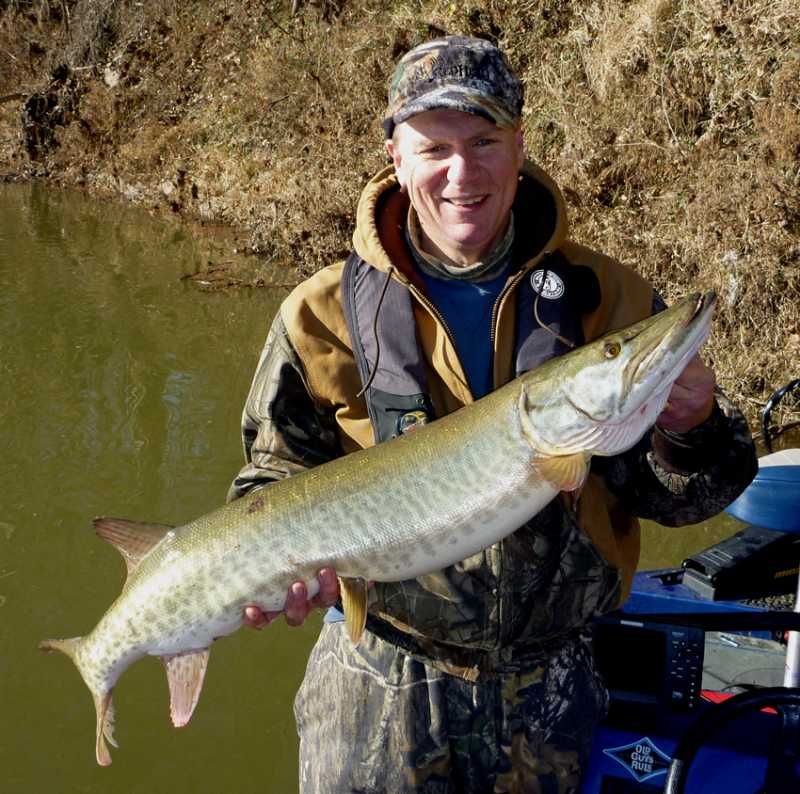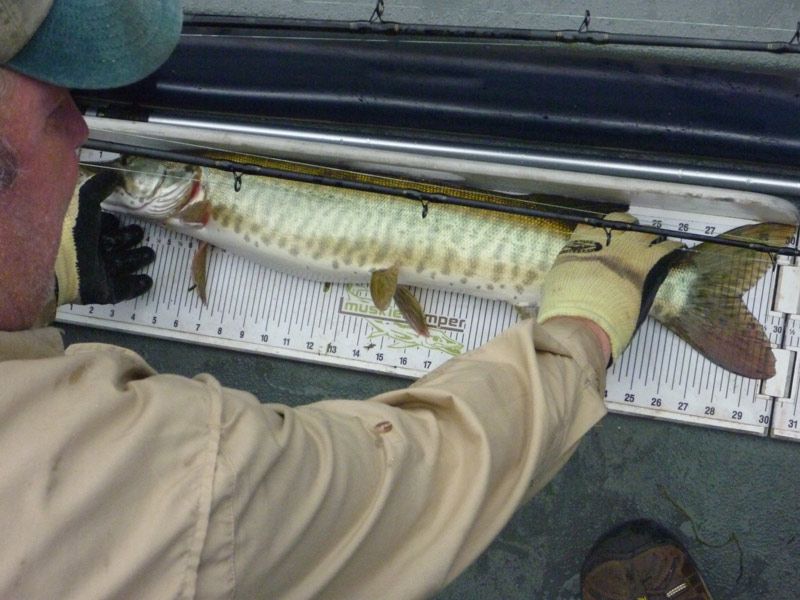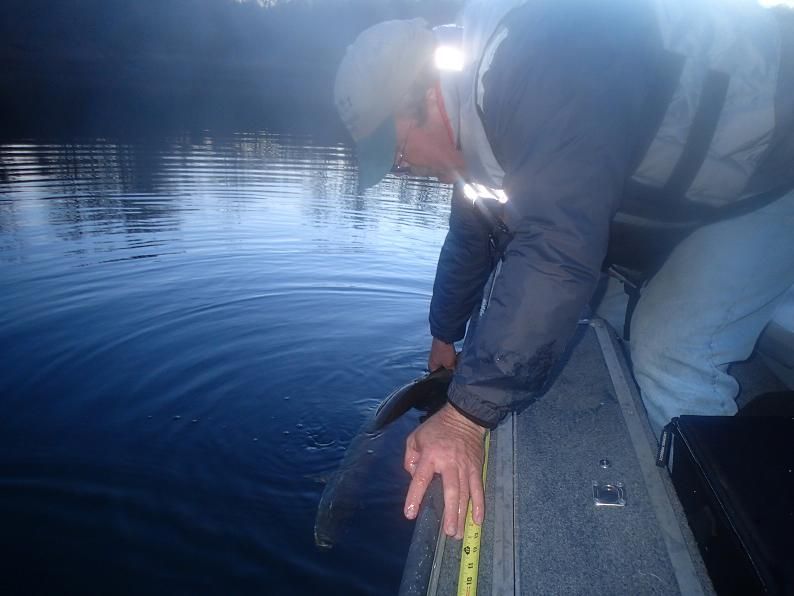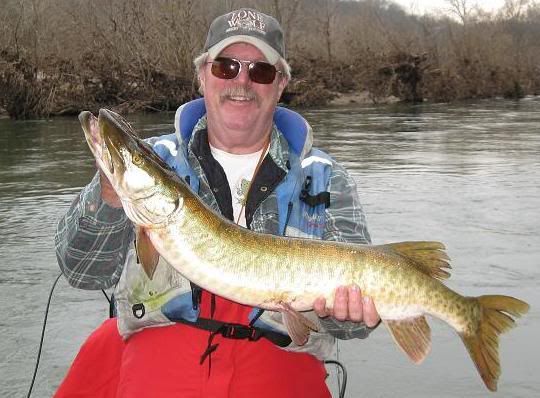In my opinion, muskies are a special kind of fish. They get huge, they're toothy, fast as heck, hit hard, fight hard, and are just plain mean and beautiful at the same time. Therefore, it's up to us to honor them by releasing them cleanly. And guess what? Like anything else, there's a right way to do it. To release muskies properly, you need the right tools for the job to maximize their chances of survival.
 |
| Catching muskies are very cool, and if you want to keep catching them, clean releases are crucial for their survival. You need to be prepared with the right tools for the job. |
1) The Proper Net: First and foremost, you need the right net for the job, and that requires an over-sized hoop and bag. I purchased the Beckman Fin Saver Pen Net. I also purchased the net cover for storage purposes. With the net cover on, it kind of looks like King Kong's ping pong paddle. This particular net has a hoop diameter of 34 inches and the bag is 40 inches deep. Why such a large net?
Beckman's website states, "Pen Fin Savers are stout “bigger fish” nets with all the Pen Series anti-tangle attributes and a practical array of hoop/bag/handle options. But they’re especially release-friendly, with smaller knotless treated mesh for a more caring and gentler contact with the fish. With a Fin Saver there’s less mesh-snarling of teeth, fins, and gill plates. Today’s trophy angler requires a rugged right-sized net for landing large fish — as well as a fish-friendly net bag for the most lively releases!"
There are other brands too that work equally well, including the Frabill Conservation Series net and the largest Stowmaster net. These nets allow for you to remove the hooks while keeping the fish alive and well in the water.
 |
| Catching fish like this one caught by my musky fishing friend, Ed, require a much larger net than used for other types of freshwater fishing to ensure a clean release. Photo courtesy of Ed Lewandoski. |
2) Jaw Spreader: Jaw spreaders are simple wire like devices that are under tension by design, and when you separate the arms it opens up spreading the jaws of the musky wide enough that you can safely remove hooks without getting bitten.
3) Hook Cutter: You can buy hook cutters from fishing companies, or purchase a bolt cutter from your hardware store. I use a Knipex 8 inch compact bolt cutter with lever action. These are always reliable and work really well. Obviously, you'll need to stock up on spare hooks. Muskies will often inhale your lure, and trying to remove deeply hooked fish is harmful to the fish, and cutting the hooks really helps their survival chances and a quick clean release of your fish. The hooks are pretty cheap compared to how often you'd need to do this. After cutting the hooks and removing the lure, remove the hooks pieces with your long nose pliers to further protect the fish.
4) Hook-Out: I use the Tyrant Tackle Hook-out. There are other brands, but I liked this one because I can also use it to retrieve lures that have fallen to the bottom of my musky tackle box, saving me arm punctures if I had to reach in there pick the lure out that fell. But the real purpose of this is to reach in and poke a hook free if it's easy to get to.
5) Extra Large Longnose Pliers: These also work well for removing hooks, especially when they are not hooked deep. You can easily provide leverage against the hook and remove that hook without getting bitten. You can buy these from musky tackle sites, like
Musky Tackle Online, or purchase them from a hardware store. I prefer stainless steel or something that doesn't rust easily. You can buy some of the other products above from MTO as well.
 |
| The tools of the trade include gloves, and top to bottom, large longnose pliers, hookout, jawspreader, and hook cutters (bolt cutters). These tools will increase the odds that the muskies that you catch and release will survive. |
The above tools are necessary to protect the fish and ensure a clean release. Now, let's discuss some other release tools that you might find useful to not only release your fish, but to protect you or allow you to take a measurement or handle your fish safely.
6) Gloves: There are several styles of gloves on the market, some providing more protection than others. I probably would buy the Lindy Joe glove but my hands don't fit in those gloves well, so I purchased some of the cheaper fishing gloves from Bass Pro Shops with the rubber coated fingers and palms. These are more for your protection than the fish, because when you lift the fish out of the net for a picture, measurement and release, your fingers might be exposed to the extra sharp gill rakers that can easily cut your fingers wide open.
 |
| Even smaller muskies like this one can cut your fingers wide open with those gill rakers. Gloves will help protect your fingers and hands. Photo courtesy of Ed Lewandoski. |
7) Bump Board: Bump boards are designed to help you to control your fish from flopping around so that you can quickly measure your fish. I currently don't own one of these, but plan to purchase one soon. I use a measuring tape to measure my fish. You could also place markings on your boat deck to do this. The bump board is the safest way for the fish though.
 |
| Bump boards like this allow you to easily and accurately measure your musky while keeping your fish under control and not flopping around on your boat deck. Obviously, this helps to protect the fish. Photo courtesy of Ed Lewandoski. |
8) Split Ring Pliers: These will help you replace your hooks after your release and allow you to continue using your hot lure by spreading the split ring making hook attachment quick and easy .
Once you've removed the hooks from your fish, care should be taken to hold your musky properly when removing them from the net and also while photographing them. The following link provides the correct way to handle muskies complete with photographic examples:
How to Properly Hold a Musky for a Photo Op
The Conservation section of that website also contains other valuable information about caring for your musky. If you are seriously interested in joining this musky addiction, then I encourage you to read the other conservation pages on the Mid-Atlantic Muskies website. There is quite a bit of info on there that I didn't cover.
 |
| After removing your lure, measuring and photographing your fish, take your time to make sure that the fish fully recovers. My fishing buddy Shawn recommends rocking the musky from side to side rather than pushing the fish through the water lengthwise. |
Some people like to use a boga grip to handle muskies. But one Conservation Officer in my state showed us pictures of fish with broken jaws that probably resulted from someone using a boga grip, and lost control of the fish. Muskies are very strong and can easily break their own jaw by twisting. If you must use a boga grip, use a quality one with the swiveling head that allows for some give when the fish moves it's head, and also make sure that you support the fish by the tail or under the belly to keep the weight off the jaw.
One quick note about photographing your catch. Your photos will look much better if you remove your sunglasses. This is true when taking any fishing picture, but it's easy to forget to take them off during the hectic moments from the time you bring your musky to the net until it's time to release them. My concern for the fish often causes me to hurry the picture taking process, and that's usually why I forget to take them off.
 |
| Don't forget to take your sunglasses off when taking a picture of your catch. I forgot to do that in this picture which would have looked much better had I taken the doggone things off. |
If you're interested in catching muskies, or catch them once in a while and don't know much about them, I hope that you found this post useful. Thank you for taking the time to read it. I wish you the best in the clean release of your next personal best musky!







No comments:
Post a Comment